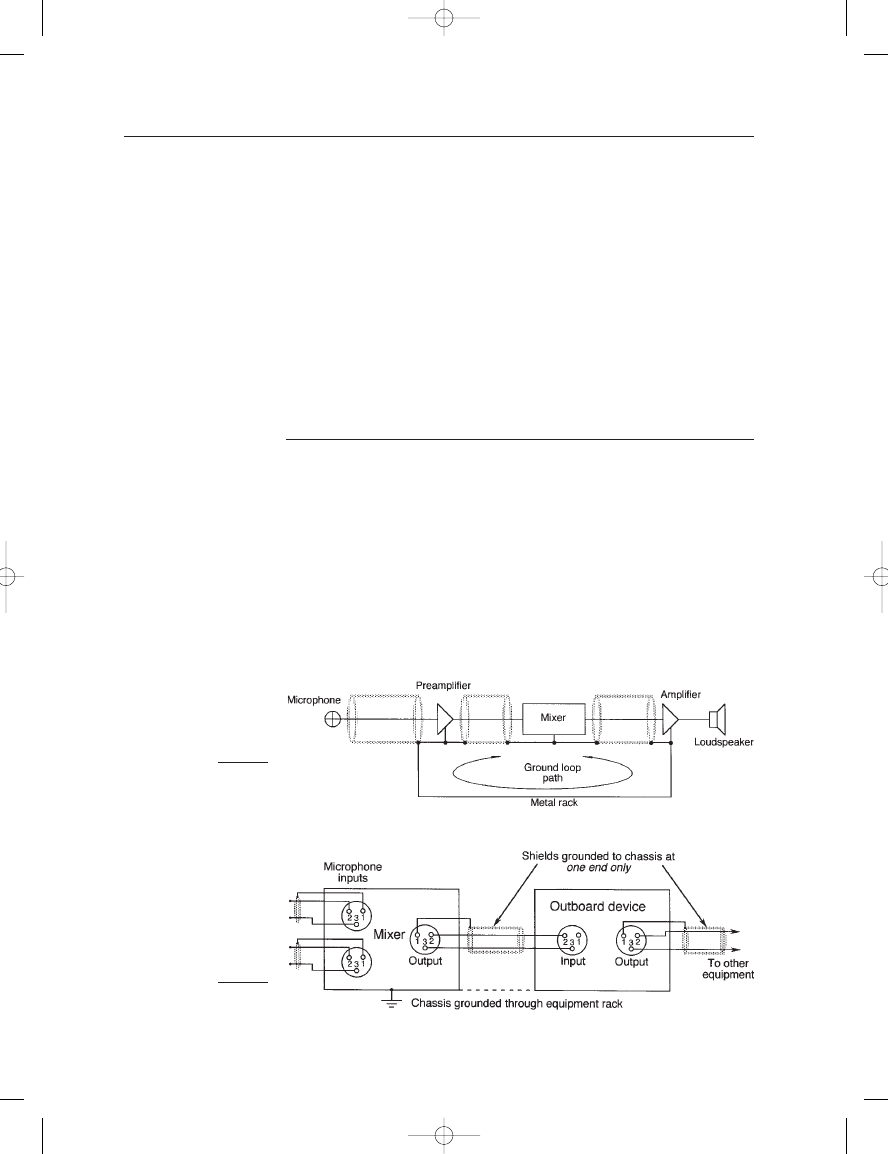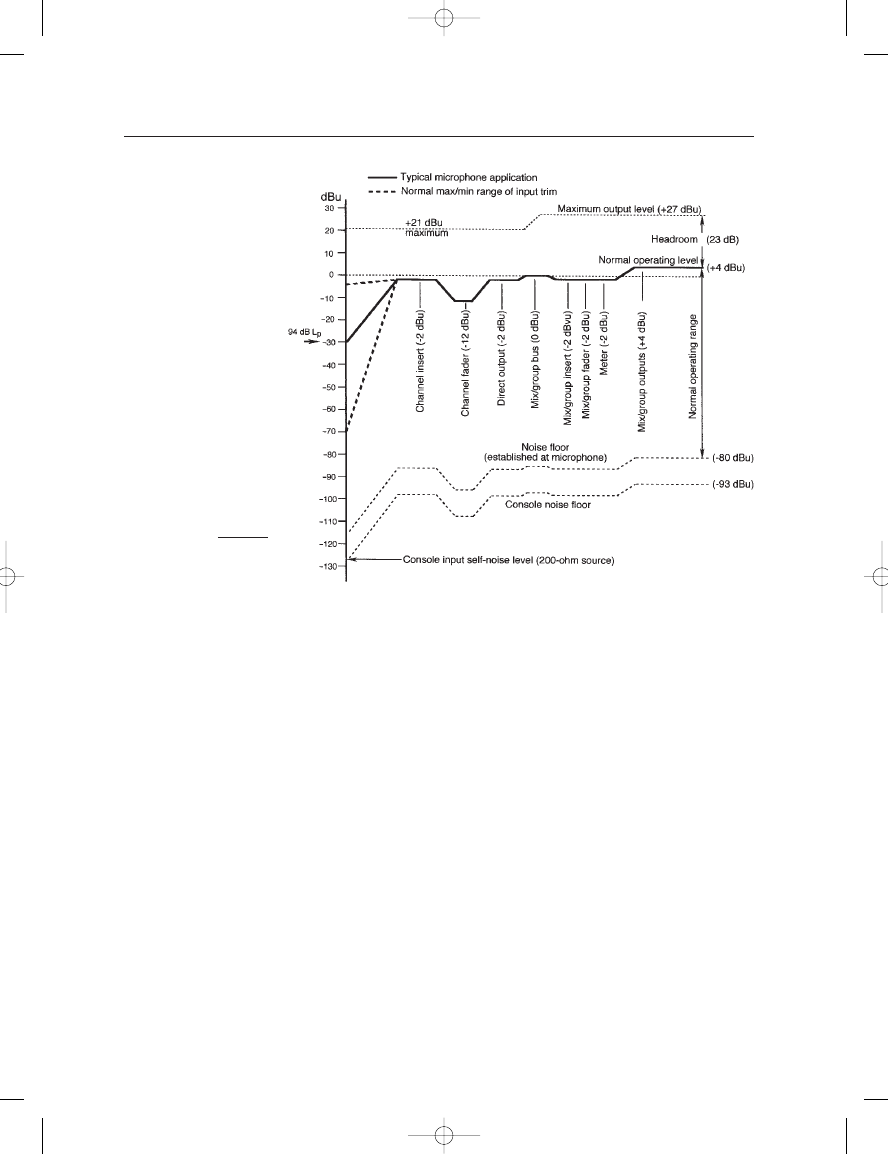ВУЗ: Казахская Национальная Академия Искусств им. Т. Жургенова
Категория: Книга
Дисциплина: Не указана
Добавлен: 03.02.2019
Просмотров: 17285
Скачиваний: 51

Interconnecting hardware should be chosen for good fit, with an
awareness that not all brands of connectors easily work together, even
though they nominally meet the standards of XLR male and female
receptacles.
Microphone “snakes” are made up of a number of individual micro-
phone cables enclosed in one outer sheath, normally numbering 12 to 16
pairs. In an effort to keep the size down, foil inner shields are normally used
on each pair. At the sending end it is preferable to have the snake terminate
in a metal box with XLR female receptacles, rather than a fan-out of female
XLR receptacles. This recommendation is based on ease of reassignment of
microphones by cable number, should that be necessary. At the receiving
end a generous fan-out should be provided for easy access to the console’s
inputs, with each cable number clearly and permanently indicated.
Capacitive coupling between pairs is generally quite low, and for sig-
nals at microphone level we can usually ignore it. However, for some
applications in sound reinforcement, there may be microphone signals
sent in one direction along the snake with concurrent line level monitor-
ing signals sent in the opposite direction. This is not recommended in
general recording practice.
CABLE TESTING
A microphone emulator circuit is shown in Figure 8–19. The circuit
shown is single-ended (unbalanced) and should not necessarily be used
to assess details of interference. However, it is excellent for determining
HF cable losses over long runs. The 40-dB input pad will reduce an
applied signal of, say 0.2 volts to 20 mV, a typical capacitor microphone
sensitivity rating at 1 pascal. The 20 mV signal appears across a 200-ohm
resistor and thus simulates the output of an actual microphone.
The circuit shown in Figure 8–20A is useful for simple cable conti-
nuity and leakage testing. Measurement across like pin numbers should
result in a virtual short-circuit. Measurements across different pin num-
bers should be made with the ohmmeter set to a high resistance range in
order to identify any stray leakage between wire pairs. The more sophis-
ticated cable tester shown at B is typical of items offered by a number of
companies. As an active device it can be used to test the following:
1. Cable continuity
2. Cable intermittent failure
3. Phantom power integrity
4. In-circuit continuity (via test tones)
5. Cable grounding integrity
Three types of cables can be tested using this system.
Polarity checking of a microphone/cable combination can be made
using a system such as is shown in Figure 8–21. Here, a LF positive-going
8: Electrical Considerations and Electronic Interface
133
Earg_08.qxd 14/9/04 2:45 PM Page 133

acoustical pulse is fed to the microphone and analyzed at the other end
of the cable run using an analyzer that detects the presence of a positive-
or negative-going pulse. If negative polarity is indicated, then there is
near certainty that a cable has been miswired or that an item of in-line
equipment is inverting the signal. Virtually all modern amplifiers and sig-
nal processing devices are non-inverting. Thus, most electrical polarity
problems encountered today are the result of local wiring mistakes.
THE MICROPHONE BOOK
134
FIGURE 8–20
Details of a simple continuity and leakage detector for microphone cables (A); a more complex cable testing apparatus (B).
(Photo B courtesy of Behringer Audio Technology.)
FIGURE 8–21
Details of a system for
checking signal polarity of
microphones.
FIGURE 8–19
An unbalanced microphone
emulator circuit providing a
loss of 40 dB.
A
B
Earg_08.qxd 14/9/04 2:45 PM Page 134

STAGE PREAMPLIFIERS AND FIBER OPTIC LINES
While normal phantom powering can easily handle cable runs up to the
100 meter range, there may be some environments where RF interference
is a chronic problem. One option is to use stage microphone-to-line
preamplifiers, which will raise the level of the transmitted signals by 40
or 50 dB with very low output impedance, thus providing considerable
immunity to induced noise and losses due to long cable runs. Stage
preamplifiers are available with remote controlled gain adjustment.
Another option is to provide on-stage digital conversion for each
microphone and transmit the individual digital signals via fiber optic
cables to a digital console in the control room. In this form, the signals
may be sent over extremely long runs with no loss.
SYSTEM CONSIDERATIONS
GROUND LOOPS
One of the most common audio transmission problems is the ground
loop. Figure 8–22 shows how a ground loop is created. Electronic
devices are cascaded as shown. Note that there is a ground path, not only
in the cables that connect the devices but also in the metal rack that
houses them. Any ac power flowing in the rack will generate an external
magnetic field, and that magnetic flux which flows through the loop will
induce a small current through it.
It is necessary to break the continuity in the loop, and this is normally
done as shown in Figure 8–23. Microphone cables are grounded at the
8: Electrical Considerations and Electronic Interface
135
FIGURE 8–22
Generation of a ground
loop.
FIGURE 8–23
Breaking the ground loop.
Earg_08.qxd 14/9/04 2:45 PM Page 135

input to the mixer in order to isolate the microphone from electrostatic
(RF) interference and also to provide a continuity path for phantom
powering. From the mixer onward, it is customary to connect the wiring
shield at the output end only as shown. In this manner the continuity of
the ground loop conductive path is broken, thus minimizing the severity
of the ground loop.
GAIN STRUCTURE
Many audio transmission problems begin with the microphone and the
initial input gain setting looking into the console. Modern consoles are
well engineered, and essentially all the operator has to do to adjust the
input and output faders to their nominal zero calibration positions and
then set normal operating levels on each input channel using the input
trim control. This may sound simple but it requires a little practice.
If the operator sets the microphone trim too low, then there is the
risk that input noise in the console will become audible, perhaps even
swamping out the noise of the microphone; if the trim is set too high,
then there is the risk that the console’s input stage will be overloaded on
loud input signals. Since the console has a wider overall operating
dynamic range than a microphone, the requirement is only to adjust the
trim so that the program delivered from the studio via the microphone
will fit comfortably within the total dynamic range of the console.
Figure 8–24 shows a level diagram for a single input channel
through a typical console. Let us assume that we have a microphone
whose sensitivity is 21 mV for an acoustical signal of 94 dB L
P
and whose
self noise floor is 10 dB(A). Further assume that the microphone’s maxi-
mum output level (0.5% THD) is 135 adB L
P
.
The microphone’s output is equivalent to
31 dBu, where dBu is
defined as:
dBu
20 log(signal voltage/0.775)
(8.1)
A level of 94 dB L
P
is typical of many instruments in the pop/rock
studio when picked up at fairly close quarters and at normal playing
levels, and thus the engineer will set the input trim control so that this
electrical level will produce console output meter deflections in the nor-
mal operating range.
Note also that with this input setting the microphone’s noise floor of
10 dB(A) will correspond to an electrical level 84 dB lower than
31 dBu, or 115 dBu. This level is about 13 dB below the noise floor
of the console, which is in the range of
128 dBu. Thus, it is clear that
the audio channel’s noise floor will be essentially that of the microphone,
with little contribution from the console’s input circuitry. As the signal
progresses through the remainder of the console, the noise floor does not
change relative to normal operating level.
THE MICROPHONE BOOK
136
Earg_08.qxd 14/9/04 2:45 PM Page 136

The microphone input channel has the capability, for undistorted con-
sole output, of handling an input signal that is 23 dB higher than 94 dB, or
117 dB L
p
. If the microphone’s input signal exceeds this amount on a
continuing basis, then the engineer must adjust the input trim to accom-
modate it. If the signal exceeds this amount only occasionally then the
engineer may make necessary adjustments at the input fader.
The microphone’s undistorted output level extends up to 135 dB L
P
,
which is 18 dB higher than the console’s maximum output capability.
As such, this microphone may be used in a wide variety of acoustical
environments, and the only adjustments that need to be made are the
microphone’s output pad (for very loud signal conditions) or resetting
the input trim as required.
SUMMING MULTIPLE INPUTS INTO A SINGLE
OUTPUT CHANNEL
During remix operations, a number of microphones are often fed to a
given output bus. For each new microphone input added to a given bus it
is apparent that the overall input levels must be adjusted so that the signal
fed downstream is uniform in level. Figure 8–25 shows the way that indi-
vidual inputs should be adjusted so that their sum will be consistent,
whether one or more microphone inputs are used.
8: Electrical Considerations and Electronic Interface
137
FIGURE 8–24
Typical console gain
structure or level diagram.
Earg_08.qxd 14/9/04 2:45 PM Page 137